Pueblo, Colorado Blood Testing Facilities
 Represents a LabCorp blood testing facility
Represents a LabCorp blood testing facility Represents a Quest Diagnostics blood testing facility
Represents a Quest Diagnostics blood testing facility

Nearby Labcorp Blood Testing facilities:
- Labcorp Center Distance: 0 m, 1619 Greenwood St. 102, Pueblo, Pueblo County, CO, 81003
- Labcorp Center Distance: 3 m, 3676 Parker Blvd Ste 200, Pueblo, Pueblo County, CO, 81008
- Labcorp Center Distance: 6 m, 729 East Spaulding Ave, Pueblo West, Pueblo County, CO, 81007
- Labcorp Center Distance: 39 m, 3225 International Cir Ste 200, Colorado Springs, El Paso County, CO, 80910
- Labcorp Center Distance: 45 m, 5664 N Union Blvd, Colorado Springs, El Paso County, CO, 80918
- Labcorp Center Distance: 47 m, 8540 Scarborough Dr Ste 170, Colorado Springs, El Paso County, CO, 80920
- Labcorp Center Distance: 80 m, 14 E Allen St, Castle Rock, Douglas County, CO, 80108
- Labcorp Center Distance: 85 m, 19641 East Parker Square Dr I, Parker, Douglas County, CO, 80134
- Labcorp Center Distance: 88 m, 10103 Ridgegate Pkwy Ste 123, Lone Tree, Douglas County, CO, 80124
- Labcorp Center Distance: 90 m, 9141 S Broadway, Highlands Ranch, Douglas County, CO, 80129
- Labcorp Center Distance: 91 m, 206 W County Line Rd Ste 150, Highlands Ranch, Douglas County, CO, 80129
- Labcorp Center Distance: 94 m, 8200 E Belleview Ave Ste 234C, Greenwood Village, Arapahoe County, CO, 80111
- Labcorp Center Distance: 95 m, 6169 S Balsam Way Ste 312, Littleton, Jefferson County, CO, 80123
- Labcorp Center Distance: 97 m, 601 East Hampden Ave Ste 340, Englewood, Arapahoe County, CO, 80113
- Labcorp Center Distance: 98 m, 1550 S Potomac Ste 325, Aurora, Arapahoe County, CO, 80012
Nearby Quest Blood Testing facilities:
- Quest Center Distance: 2 m, 1231 S Prairie Ave, Pueblo, Pueblo County, CO, 81005-2022
- Quest Center Distance: 6 m, 1017 N Market Plz, Pueblo, Pueblo County, CO, 81007-1530
- Quest Center Distance: 31 m, 6925 Mesa Ridge Pkwy, Fountain, El Paso County, CO, 80817-1504
- Quest Center Distance: 35 m, 1414 Main St, Canon City, Fremont County, CO, 81212-3906
- Quest Center Distance: 37 m, 2749 Janitell Road, Colorado Springs, El Paso County, CO, 80906-4102
- Quest Center Distance: 42 m, 2890 N Powers Blvd, Colorado Springs, El Paso County, CO, 80922-2800
- Quest Center Distance: 45 m, 6140 Tutt Blvd, Colorado Springs, El Paso County, CO, 80923-3574
- Quest Center Distance: 46 m, 840 Village Center Dr, Colorado Springs, El Paso County, CO, 80919-3603
- Quest Center Distance: 54 m, 1101 E Us Highway 24, Woodland Park, Teller County, CO, 80863-2121
- Quest Center Distance: 57 m, 624 W Highway 105, Monument, El Paso County, CO, 80132-9169
- Quest Center Distance: 86 m, 11051 S Parker Rd, Parker, Douglas County, CO, 80134-7441
- Quest Center Distance: 94 m, 27152 Main St, Conifer, Jefferson County, CO, 80433-8546
- Quest Center Distance: 95 m, 6179 S Balsam Way, Littleton, Jefferson County, CO, 80123-3095
- Quest Center Distance: 97 m, 201 E Jefferson Ave, Englewood, Arapahoe County, CO, 80113-3726
- Quest Center Distance: 98 m, 1411 S Potomac St, Aurora, Arapahoe County, CO, 80012-4542
Colorado Hormone Replacement Therapy Solutions
Are you interested in what Hormone Replacement Therapy can do for you, but don't know where to turn? You've come to the right place! The Conscious Evolution Institute provides real, quality HRT services to residents of Colorado 30 years and older. We provide a number of proven medical therapies, from Human Growth Hormone Injections to Testosterone Restoration Therapy.
With just a simple appointment, we can get all of the health information from you that we need to make an informed diagnosis. We have affiliate medical professionals situated all throughout the state. You can meet at their office or even arrange for them to visit you at your home. Just a quick physical and blood sample, and our clinical specialists will be able to accurately assess your medical condition and suggest Hormone Therapies that can enhance your life and well-being.
Human Growth Hormone Injections in Colorado
In recent decades, there has been a stigma associated with HGH Injections because of the way that they have been abused by weight lifters and athletes for personal gain. This stigma has been fading over the last decade, however, as more and more benefits of Bio-Identical HGH Hormone Replacement Therapy become apparent.
For men and women suffering from Age-Related Human Growth Hormone Deficiency (also known as Somatopause), Hormone Optimization with HGH can help them get their life and their health back on track. Symptoms of HGH Deficiency include changes in bodyfat composition, loss of muscle mass, depression, trouble sleeping, and diabetes. HGH Injections can restore normal Hormone Balance, replacing the Growth Hormone that the body is no longer producing in sufficient supply.
Sermorelin Acetate Therapy for Colorado Residents
HGH Shots aren't the only means to restore youthful HGH Levels, however. Another treatment, known as Sermorelin Acetate Therapy, has also been clinically proven to restore Growth Hormone Balance. Sermorelin is highly effective, because it actually has the ability to encourage the human pituitary to produce natural Human Growth Hormone. Because of the Somatostatins that the brain produces, there is no risk of overdose!
Low-T Treatments in Colorado
Are you having trouble in the bedroom? Before you turn to pills for erectile dysfunction, get tested for Testosterone Deficiency. ED pills increase blood flow, making it easier to engage in sexual activity, but it does not restore hormone balance, potentially leaving you susceptible to a number of medical conditions such as hypertension, diabetes, and even heart attack and stroke.
If you qualify for Testosterone HRT, you can restore your Testosterone Balance with a number of treatments, including Creams, Gels, and Injections. Don't hide your problems with pills, get the treatment that you deserve with Bio-Identical Testosterone!
HCG Weight Loss Treatments in Colorado
For many people, losing weight feels next to impossible. They try and try, but can't stick to a diet for more than a few days or weeks at a time. If you've tried all the fad diets out there and are still having trouble losing the weight, Bio-Identical HCG Weight Loss Therapy may be the answer you've been looking for. HCG Therapy is a modern weight loss treatment which combines a low-calorie diet with Bio-Identical Hormone Injections to encourage and facilitate weight loss.
The HCG Diet is highly effective for three reasons. First, it quietens the sensation of hunger associated with a restrictive diet. Second, it encourages the body to burn adipose fat with high efficiency, preserving your muscles and structural fat. Third, it uses that bodyfat to meet the energy needs of the body, mitigating fatigue associated with low-calorie diets.
Major cities in Colorado
Denver is the largest city in the state of Colorado, as well as its capital. Denver is often referred to as The Mile-High City, because it is the highest-altitude capital in the United States, resting at over 5,000 feet. Downtown Denver is located along the South Platte River and Cherry Creek.
Denver is the home of the Denver Broncos of the NFL and the Colorado Rockies of the MLB. Denver has one of the largest economies in the United States, and is a major shipping route for cross country rail and trucking. Denver is a great city for restaurant start-ups, and is the home of Chipotle, Qdoba, and Quizno's just to name a few. Denver also has large High-Tech and mining presensces.
Colorado Springs
Colorado Springs is the second largest city in Colorado, and is located in the east-central portion of the state. Colorado Springs is located even higher in the Rocky Mountains than Denver, resting at over 6,000 feet. The city is also located near the base of one of the most famous mountains in the United States: Pike's Peak. Colorado Springs is considered one of the best cities to live in the country by Outside and Money Magazine. Colorado Springs is home to the United States Air Force Academy.
Aurora
Aurora is the third largest city in Colorado, and is located immediately east and adjacent to Denver. Aurora was first founded as Fletcher in 1891, and became Aurora in 1929. The largest employer in the city is Buckley Air Force Base, and the largest private employers are The Children's Hospital of Aurora and Raytheon. The city is also known for its beautiful parks, including Cherry Creek State Park and the Morrison Nature Center.
Fort Collins
Fort Collins is the fourth most populated city in the state of Colorado, and is located in the north-central area of the state. Fort Collins was originally a military base in the 19th century, but today, it is known as the home of the Colorado State Rams. The city has a significant amount of high tech industry, and its largest private employer is Hewlett Packard.
Lakewood
Lakewood, Colorado is the fifth most populated city in the state, and is a western suburb of Denver. Lakewood has been recognized as a quality place to live, and in 2011, was registered as an All-American city. The largest public employer in Lakewood is the Denver Federal Center, and the largest private employer is Terumo, a medical manufacturing company.
All About Pueblo, Colorado Geographic Area
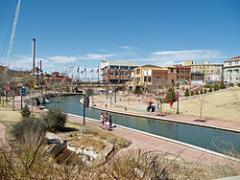
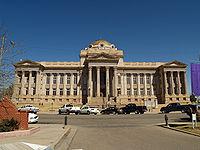
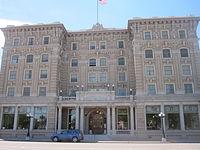
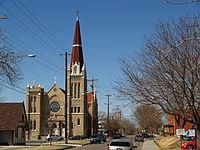
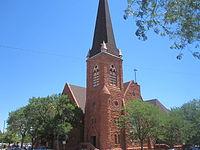
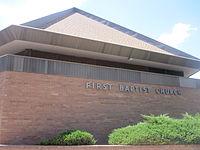
Pueblo ( /ËnpwÉobloÊo/) is a Home Rule Municipality that is the county seat and the most populous city of Pueblo County, Colorado, United States. The population was 106,595 in 2010 census, making it the 246th most populous city in the United States.
/ËnpwÉobloÊo/) is a Home Rule Municipality that is the county seat and the most populous city of Pueblo County, Colorado, United States. The population was 106,595 in 2010 census, making it the 246th most populous city in the United States.
Pueblo is situated at the confluence of the Arkansas River and Fountain Creek 112 miles (180 km) south of the Colorado State Capitol in Denver, and 43 miles south of Colorado Springs. The area is considered to be semi-arid desert land, with approximately 12 inches (304.80 mm) of precipitation annually; however with its location in the "banana belt", Pueblo tends to get less snow than the other major cities in Colorado. Pueblo is the heart of the Pueblo Metropolitan Statistical Area and an important part of the Front Range Urban Corridor. Pueblo is one of the largest steel-producing cities in the United States; because of this Pueblo is referred to as the "Steel City". The Historic Arkansas River Project (HARP) is a river walk in the Union Avenue Historic Commercial District, and shows the history of the Pueblo Flood. Pueblo is the economic and shopping hub for the "Pueblo region" that spans 20 counties in southern Colorado and Northern New Mexico.
George Simpson, among other traders and trappers such as Mathew Kinkead, claimed to have helped construct the plaza that became known as El Pueblo or Fort Pueblo around 1842. George married Juana Maria Suaso and lived there for a year or two before moving; however, Simpson had no legal title to the land. The adobe structures were built with the intention of settlement and trade next to the Arkansas River, which then formed the U.S./Mexico border. About a dozen families lived there, trading with Native American tribes for hides, skins, livestock, as well as (later) cultivated plants, and liquor. Evidence of this trade, as well as other utilitarian goods, such as Native American pottery shards were found at the recently excavated site. According to accounts of residents who traded at the plaza (including that of George Simpson), the fort was raided sometime between December 23 and December 25, 1854, by a war party of Utes and Jicarilla Apaches under the leadership of Tierra Blanca, a Ute chief. They allegedly killed between fifteen and nineteen men and captured two children and one woman. The trading post was abandoned after the raid, but it became important again between 1858 and 1859 during the Colorado Gold Rush of 1859.
The current city of Pueblo represents the consolidation of four towns: Pueblo (incorporated 1870), South Pueblo (incorporated 1873), Central Pueblo (incorporated 1882), and Bessemer (incorporated 1886). Pueblo, South Pueblo, and Central Pueblo legally consolidated as the City of Pueblo between March 9 and April 6, 1886. Bessemer joined Pueblo in 1894.
The consolidated city was once a major economic and social center of Colorado, and was home to important early Colorado families such as the Thatchers, the Ormans and the Adamses. Until a series of major floods culminated in the Great Flood of 1921, Pueblo was considered the 'Saddle-Making capital of the World'. Roughly one-third of Pueblo's downtown businesses were lost in this flood, along with a substantial number of buildings. Pueblo has long struggled to come to grips with this loss, and has only recently begun a resurgence in growth.
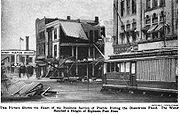
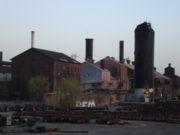
The economic situation of Pueblo was further exacerbated by the decline of American steel in the 1970s and 1980s, and Pueblo still actively seeks to diversify its economic base. The City features a riverwalk, extensive trail system, industrial park, and revitalized downtown area to this effect.
The main industry in Pueblo for most of its history was the Colorado Fuel and Iron (CF&I) steel mill on the south side of town. The steel-market crash of 1982 led to the decline of the company. After going through several bankruptcies, the company was acquired by Oregon Steel Mills and changed its name to Rocky Mountain Steel Mills. As Rocky Mountain Steel, the company was plagued with labor problems, mostly due to accusations of unfair labor practices. The problems culminated with a major strike in 1997, leading to most of the workforce being replaced.
However, in September 2004, both local Unions 2102 & 3267 won the strike and the unfair labor practice charges. All of the striking steel workers were returned to their jobs, and the company was forced to repay them a record amount of back pay for the 7 years they were on strike. Some have called this a significant win for the labor union and the many families affected by the 7 year strike. In 2007, not long after Oregon Steel made amends with the union and its workers, Evraz Group, one of Russia's biggest steel producers, agreed to buy the company for $2.3 billion dollars.
Of the many production and fabrication mills which once existed on the site, only the steel production (electric furnaces, used for scrap recycling), rail, rod, bar, and seamless tube mills are still in operation. The wire mill was sold in the late 1990s to Davis Wire, which still produces products such as fence and nails under the CF&I brand name.
The facility operated blast furnaces until 1982, when the bottom fell out of the steel market. The main blast furnace structures were torn down in 1989, but due to asbestos content, many of the adjacent stoves still remain. The stoves and foundations for some of the furnaces can be easily seen from Interstate 25, which runs parallel to the plant's west boundary.
Several of the administration buildings, including the main office building, dispensary, and tunnel gatehouse were purchased in 2003 by the Bessemer Historical Society. In 2006, they underwent renovation. In addition to housing the historic CF&I Archives, they also house the Steelworks Museum of Industry and Culture.
Pueblo is the hometown of four Medal of Honor recipients - Drew D. Dix, Raymond G. Murphy, William J. Crawford, and Carl L. Sitter. U.S. President Dwight D. Eisenhower upon presenting Raymond G. "Jerry" Murphy with his Medal in 1953 commented, "What is it... something in the water out there in Pueblo? All you guys turn out to be heroes!" In 1993, the City Council adopted the tagline "Home of Heroes" because it can claim more recipients per capita than any other city in the United States. On July 1, 1993, the Congressional Record recognized Pueblo as the "Home of Heroes." There is a memorial to the recipients of the medal at the Pueblo Convention Center. Central High School is known as the "School of Heroes," as it is the alma mater of two recipients, Sitter and Crawford, more than any other high school in the country.
President Woodrow Wilson, on a speaking tour to gather support for the entry of the United States into the League of Nations, collapsed on September 25, 1919 following a speech in Pueblo. He suffered a stroke a week later which incapacitated him for the rest of his presidency.
Theodore Roosevelt arrived at the Pueblo Union Depot in order to lay the first brick down for the Y.M.C.A., and also check the water resources in Colorado.
President Dwight D. Eisenhower Jan. 16, 1957, toured drought-stricken regions of Pueblo County amid 20-degree weather.
President George H. W. Bush (when he was Vice President) visited the Pueblo Nature Center's Raptor Center to release an American Bald Eagle that had its wings healed.
Other national leaders to visit Pueblo include Presidents John F. Kennedy and Bill Clinton, Senator John Kerry, and Vice President Al Gore.
In the 2008 presidential campaign, both major party candidates, Barack Obama and John McCain, visited Pueblo as part of their campaigns. Colorado was considered a key swing state in that election, with Obama becoming the first Democratic candidate since Clinton in 1992 to win the state's electoral votes.
Historically the other major employer in Pueblo was the State Hospital, which formerly served the entire state. Established in 1879 as the Colorado State Insane Asylum, it was known as the Colorado State Hospital after 1917. In 1991, the name was changed to the Colorado Mental Health Institute at Pueblo (CMHIP). Currently under construction is the new Forensic Medium and Maximum Security Center, a 200-bed, state-of-the-art high-security facility.
Pueblo is home to Colorado State University-Pueblo (CSU-Pueblo), a regional comprehensive university. It is part of the Colorado State University System (CSU System), with about 6,000 students. On May 8, 2007, CSU-Pueblo got approval from the Board of Governors of the Colorado State University System to bring back football as a member of the Rocky Mountain Athletic Conference. The first game was played in the fall of 2008 at the Thunderbowl, a new stadium at CSU-Pueblo which holds over 12,000 people.
Pueblo Community College (PCC) is a two-year, public, comprehensive community college, one of thirteen community colleges within the Colorado Community College System (CCCS). It operates three campuses serving a widely dispersed eight-county region in Southern Colorado. The main campus is located in Pueblo and serves Pueblo County. The Fremont Campus is located approximately 35 miles (56 km) west of Pueblo in CaR±on City and serves Fremont and Custer Counties. The Southwest Campus, 280 miles (450 km) southwest of Pueblo, serves Montezuma, Dolores, La Plata, San Juan, and Archuleta counties. PCC is a Hispanic Serving Institution as designated by the Federal Government. Approximately 5,000 students attend PCC per semester.
Pueblo County has thirteen high schools. Pueblo Centennial High School was founded just north of downtown on Eleventh St. in 1876, the year Colorado became a state. Centennial was rebuilt on a new site to the northwest in 1973. Pueblo Central High School was founded in Bessemer in 1882. Central's present campus on E. Orman Ave. was built in the 1920s and expanded in the early 1970s. Its original building still stands four blocks away on E. Pitkin Ave. Pueblo South High School and Pueblo East High School were built in the late 1950s to accommodate the Baby Boomers. Pueblo County High School, east of the city in Vineland, serves rural residents. Rye High School is in a foothills town southwest of Pueblo. Pueblo West High School is the newest (built in 1997), in the northwestern suburb of Pueblo West. The former Pueblo Catholic High School became Roncalli Middle School in the early 1970s. Other Pueblo area high schools include Dolores Huerta Preparatory High School, Southern Colorado Early College, School of Engineering and Biomedical Science(formerly Pueblo Technical Academy), Parkhill Christian Academy, and the Health Academy.
Pueblo is located at 38 °16 a²1 a³N 104 °37 a²13 a³W / 38.26694 °N 104.62028 °W / 38.26694; -104.62028 (38.266933, na104.620393).
According to the United States Census Bureau, the city has a total area of 45.4 square miles (117.6 km2), of which, 45.1 square miles (116.8 km2) is land and 0.3 square miles (0.78 km2) is water (99,34% and 0,66% respectively).
Pueblo is 100 miles (160 km) south of Denver and is on the front range of the Rocky Mountains.
Pueblo sits in a "high desert" area of terrain in southern Colorado. Pueblo has a steppe climate (Koppen BSk), with four distinct seasons. Winter days are usually mild, but the high does not surpass freezing on 18 days per year, and lows fall to 0 °F ( na17.8 °C) on 8 nights. Snowfall usually falls in light amounts, and due to the high altitude, and the accompanying stronger sun, rarely remains on the ground for long. March is the snowiest month, and the seasonal average is 33.7 inches (86 cm); however, the median is 10 inches (25 cm) lower, and most years see no snow in October, and May or September snow is exceedingly rare. Summers are hot and dry, with normal daytime temperatures in the 90's °F (31 ae33 °C), and 90 °F (32.2 °C) or greater highs are seen 66 days per year, with 100 °F (37.8 °C) or greater being seen 9 times. Diurnal temperature ranges are large throughout the year, averaging 31.5 °F (17.5 °C).
Precipitation is generally low, with the winter months receiving very little. Sunshine is abundant throughout the year, with an annual total of nearly 3470, or 79% of the possible total. Pueblo is considered a "high desert" climate, and sits on the desert lands in southern Colorado between Pueblo and the Royal Gorge.
Pueblo is the home to Colorado's largest single event, the Colorado State Fair, held annually in the late summer, and the largest parade, the state fair parade, as well as an annual Chili Festival.
The National Street Rod Association's Rocky Mountain Street Rod Nationals have been held in Pueblo for twenty-three years, largest and premier street rod event in the region.
Pueblo is the hometown of Dutch Clark, the first man from Colorado in the NFL Hall of Fame. Pueblo's largest football stadium is named after him. There are two long-standing high school rivalries that takes place at this stadium, The Bell Game, which is played by The Pueblo Central Wildcats and the Pueblo Centennial Bulldogs and also the Cannon Game which is played by the Pueblo South Colts and the Pueblo East Eagles.
Pueblo is home to the PBR (Professional Bull Riders) team finals held at the state fair events center during the Colorado state fair and shown all over the world. In 2008 the PBR moved their corporate headquarters to Pueblo.
Pueblo is the home of the Federal Citizen Information Center, operated by the General Services Administration, and its Consumer Information Catalog. For over 30 years, public service announcements invited Americans to write for information at "Pueblo, Colorado, 81009" (though the official address is Post Office Box 100). In recent times GSA has incorporated Pueblo into FCIC's toll-free telephone number (1-888-8 PUEBLO) and web address (www.pueblo.gsa.gov).
Vestas has announced that it will build the largest (nearly 700,000 square feet) wind turbine tower manufacturing plant in the world at Pueblo's industrial park. A number of scientific studies now list Pueblo as the state's best place for solar energy and a good place for solar companies to locate.
Small Smiles Dental Centers originated from a dental clinic established in Pueblo in 1928. Small Smiles had its headquarters in Pueblo until they moved to Nashville, Tennessee in 2006.
According to Pueblo's 2011 Comprehensive Annual Financial Report, the top employers in the city are:
As of the census of 2000, there were 102,121 people, 40,307 households, and 26,118 families residing in the city. The population density was 2,265.5 people per square mile (874.6/km2). There were 43,121 housing units at an average density of 956.6 per square mile (369.3/km2). The racial makeup of the city was 76.21% White, 2.41% African American, 1.73% Native American, 0.67% Asian, 0.06% Pacific Islander, 15.20% from other races, and 3.71% from two or more races. Latinos made up 44.13% of the population. 10.1% were of German, 8.1% Italian, 6.0% American, 5.5% English and 5.4% Irish ancestry according to Census 2000.
According to the 2005 Census estimates, the city had grown to an estimated population of 104,951 and had become the ninth most populous city in the state of Colorado and the 245th most populous city in the United States.
There were 40,307 households out of which 29.8% had children under the age of 18 living with them, 44.5% were married couples living together, 15.1% had a female householder with no husband present, and 35.2% were non-families. 30.0% of all households were made up of individuals and 12.9% had someone living alone who was 65 years of age or older. The average household size was 2.44 and the average family size was 3.03.
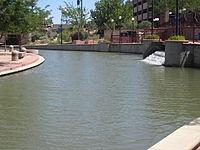
In the city the population was spread out with 25.1% under the age of 18, 10.3% from 18 to 24, 26.6% from 25 to 44, 21.4% from 45 to 64, and 16.6% who were 65 years of age or older. The median age was 36 years. For every 100 females there were 93.9 males. For every 100 females age 18 and over, there were 90.2 males.
The median income for a household in the city was $29,650, and the median income for a family was $35,620. Males had a median income of $29,702 versus $22,197 for females. The per capita income for the city was $16,026. About 13.9% of families and 17.8% of the population were below the poverty line, including 24.3% of those under age 18 and 9.1% of those age 65 or over.
The crime rate in Pueblo is higher than the national average. In 2005, Pueblo reported 13 murders, 22 rapes, 162 robberies, 489 assaults, 1,525 burglaries, 4,978 larceny thefts, and 478 auto thefts.
The local airport, Pueblo Memorial Airport, lies to the east of the city. It is home to the Pueblo Weisbrod Aircraft Museum (named for Fred Weisbrod, late city manager), reflecting the airport's beginnings as an Army Air Corps base in 1943.
Pueblo has six sister cities, as designated by Sister Cities International:

Word Count: 3699





